Puerto Escondido to Quetzaltenango
May, 2004
May 9th
Puerto Escondido was a relaxing place so we stayed another day, for a chance to do nothing... a walk on the beach into town, shopping for the same curios available at every place we have been so far... a nap in the afternoon...
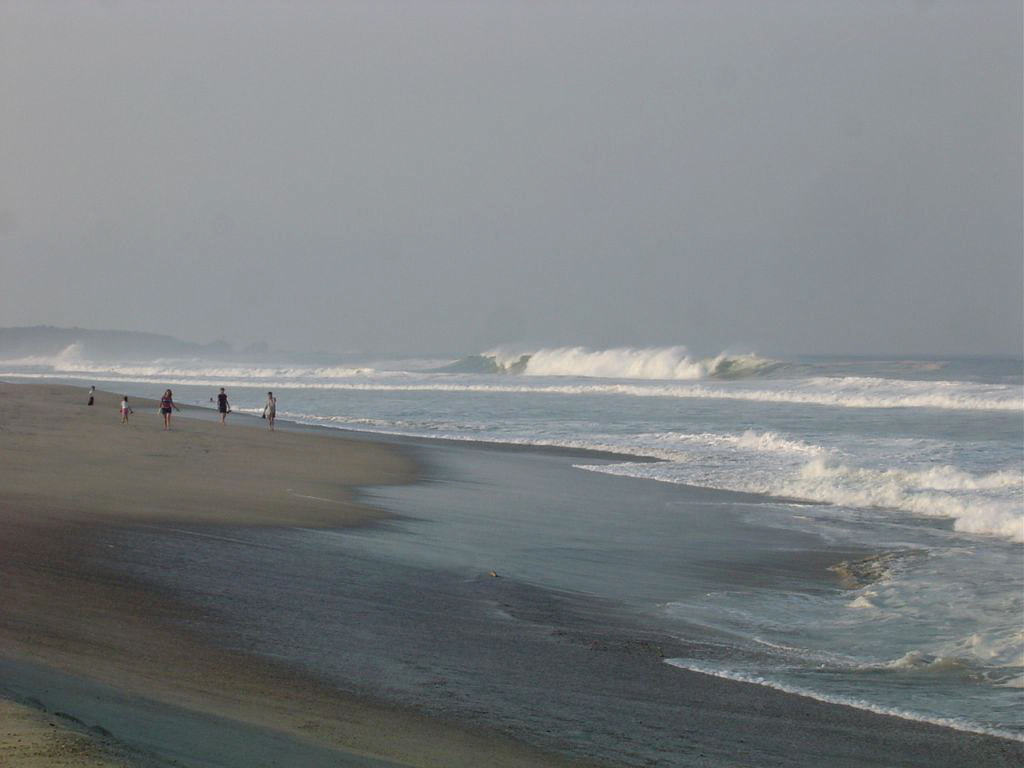
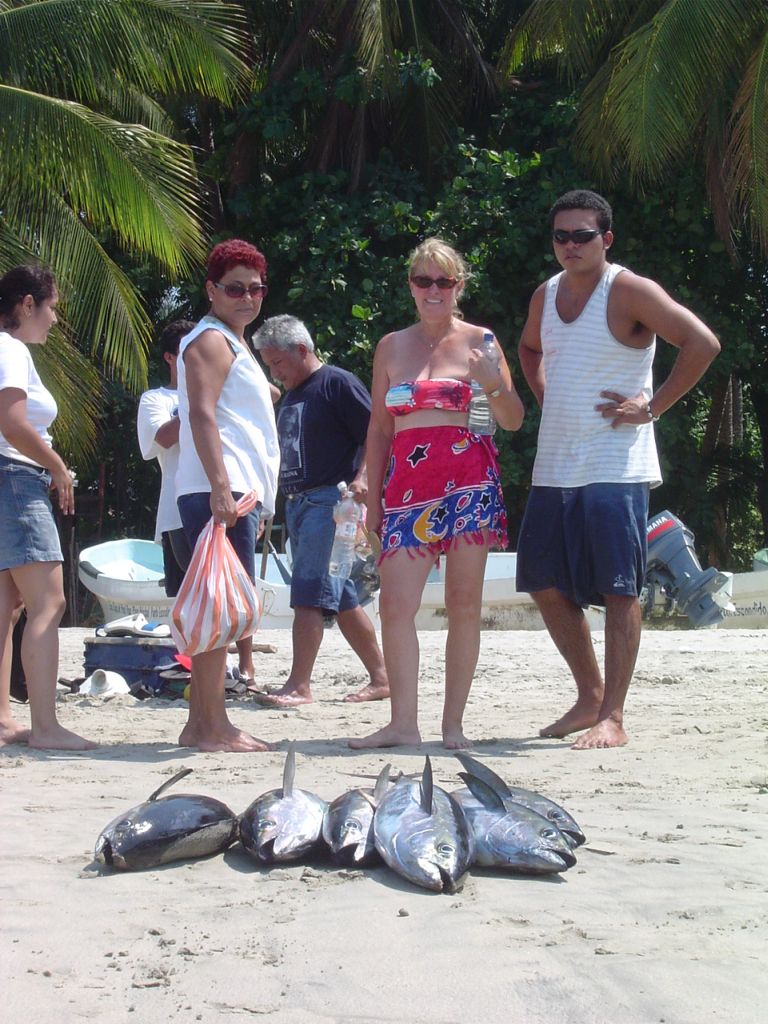
May 10th
The road north to Oaxaca, winding up into the hills, was destined to be the slowest run so far, with 250 km (180 miles) taking six hours. The half-way point was punctuated, literally, by a sharp rock which I, showing supreme driving skill, managed to hit, fair and square, with the right front tire. It wasn't long before it was obvious that we were driving on a flat tire. I pointed out that the tire was clearly flat only on the bottom, but Elsa insisted that I change it. A young fellow, struggling with boredom on the desolate road, stopped to watch and offer suggestions. It's been many years since I changed a tire, but like riding a bicycle, the knack just hangs on. In twenty minutes, we were completing the run under a yellow flag. Elsa pointed out every rock on the road, large or small, reminding me that we were in total jeopardy, due to my lack of attention, and that the battery, cooling system, and transmission were quite likely to fail soon as well.
Oaxaca, is like every other Mexican city; the streets are narrow and crowded. Oaxaca throws in an abundance of one-way streets to add a final touch. The hotel we sought was new, so we couldn't ask for it by name; we had to use a street name and a number. An original and useful concept one might think, but not in Mexico. Elsa took the task, once again, by virtue of speaking Spanish, of asking people on the street how to get there. One would think that none had ever been more than two blocks from where they were currently standing. I double-parked, time after time, through the whole process, until a motorcycle cop pulled up behind me and started his siren. Elsa jumped at the chance for a police escort to the hotel, which he thoughtfully provided, though skipping the siren and red lights I thought would have added to our arrival. One more small bottle of schnapps fell into good hands.
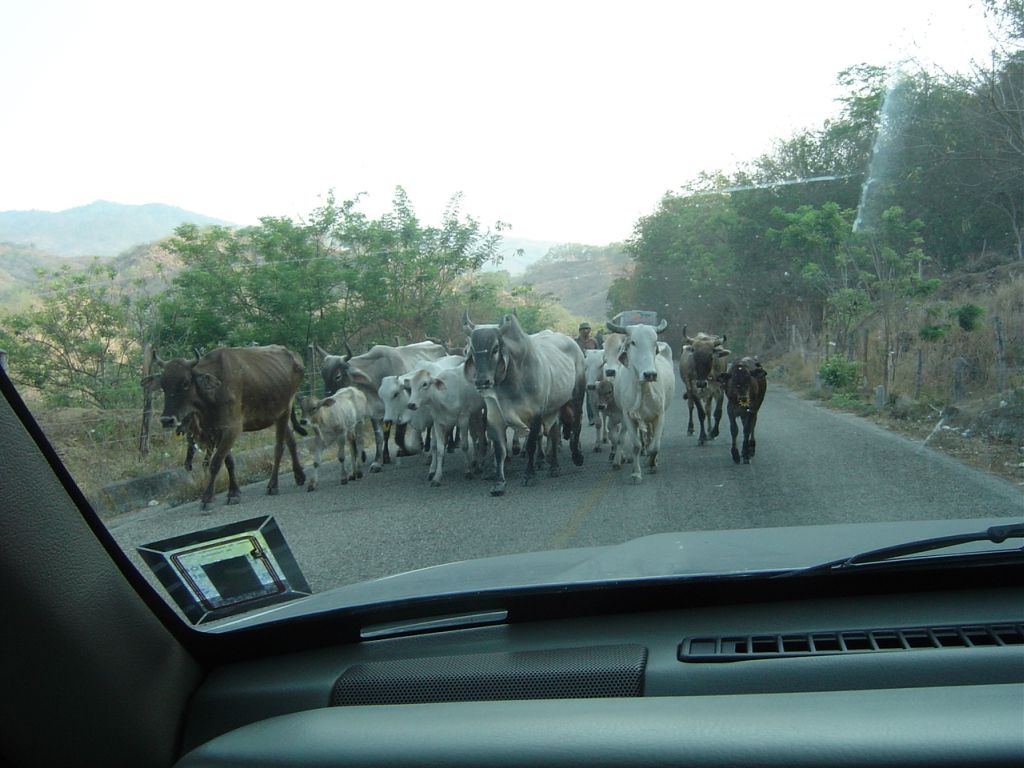
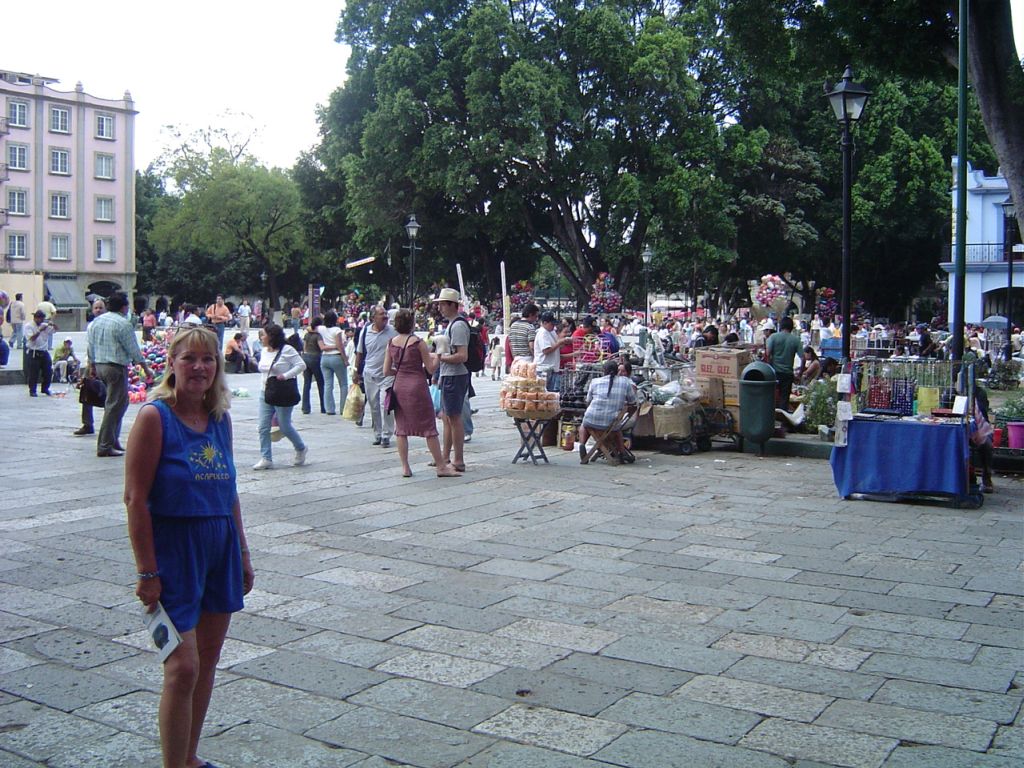
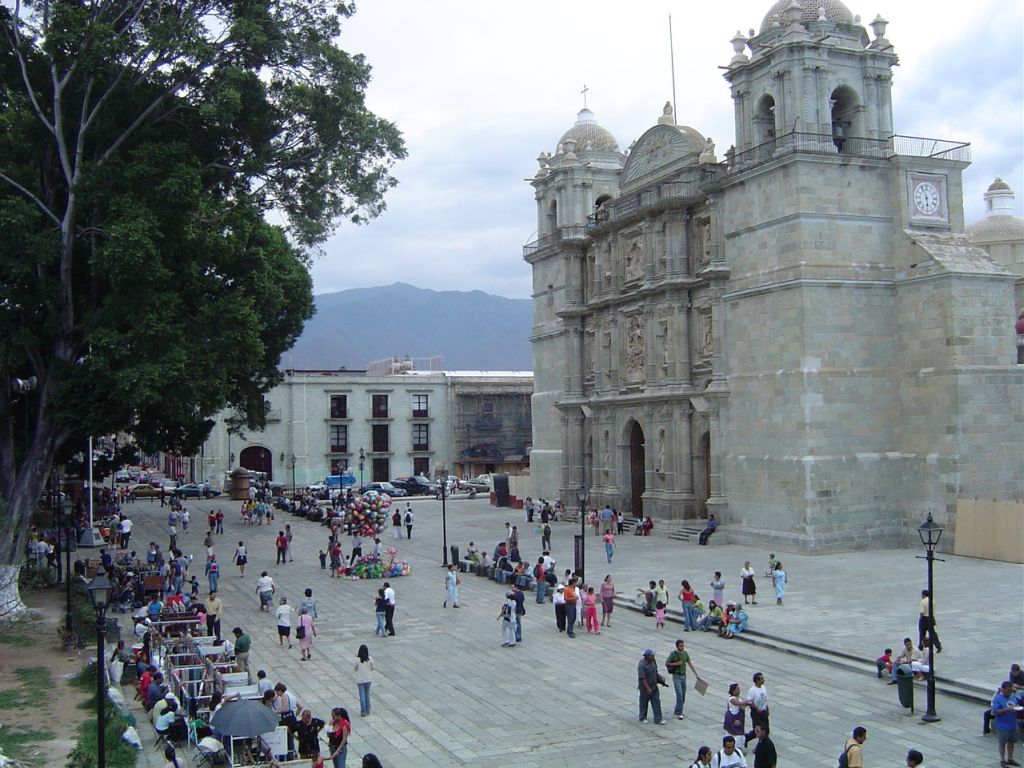
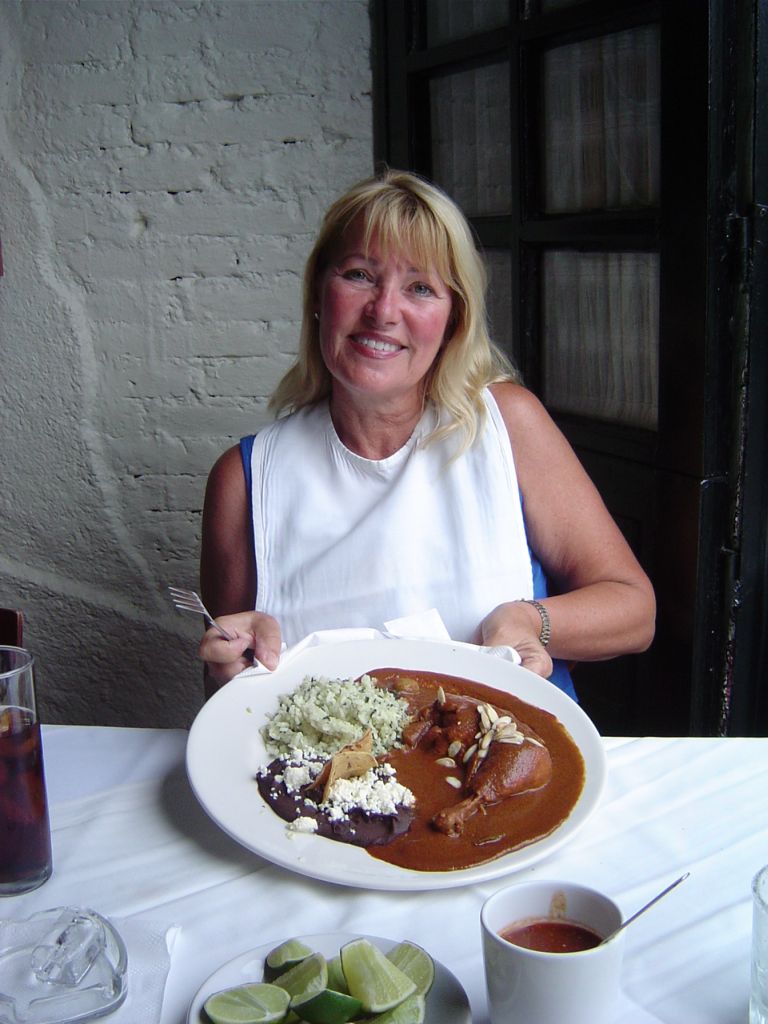
May 11th
Monte Alban, meaning White Mountain, is a famous ruin just southwest of Oaxaca. We signed up for a tour, which we enjoyed, except for the obligatory stop at a pottery factory on the way back.
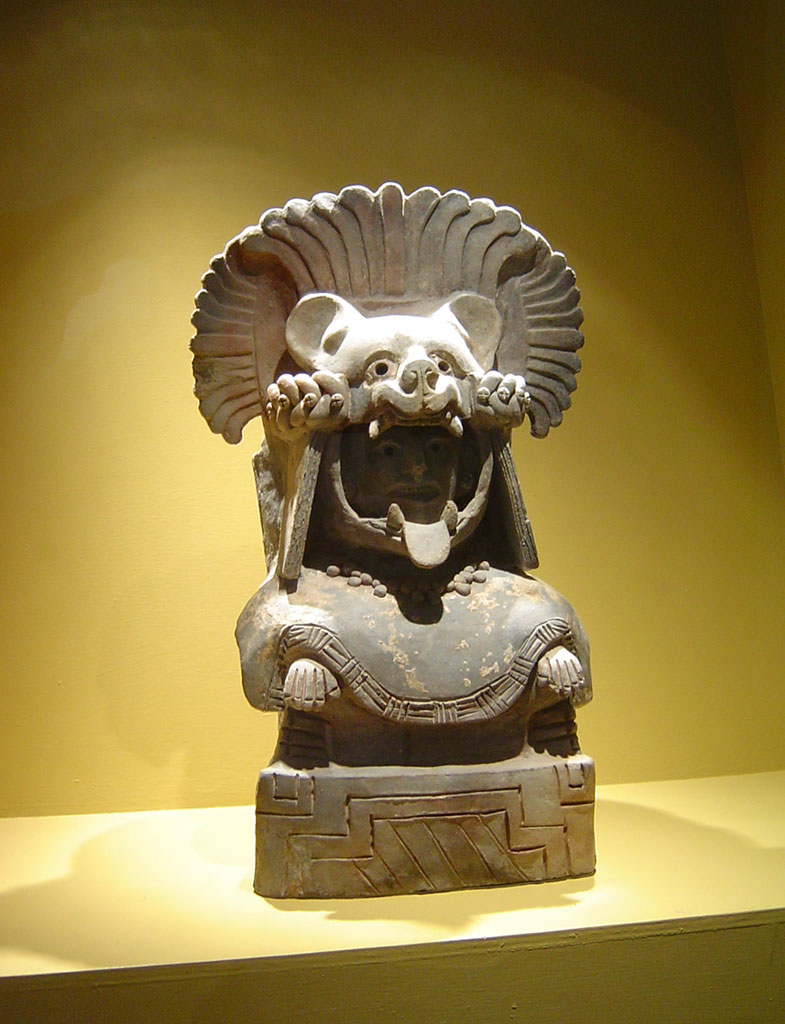
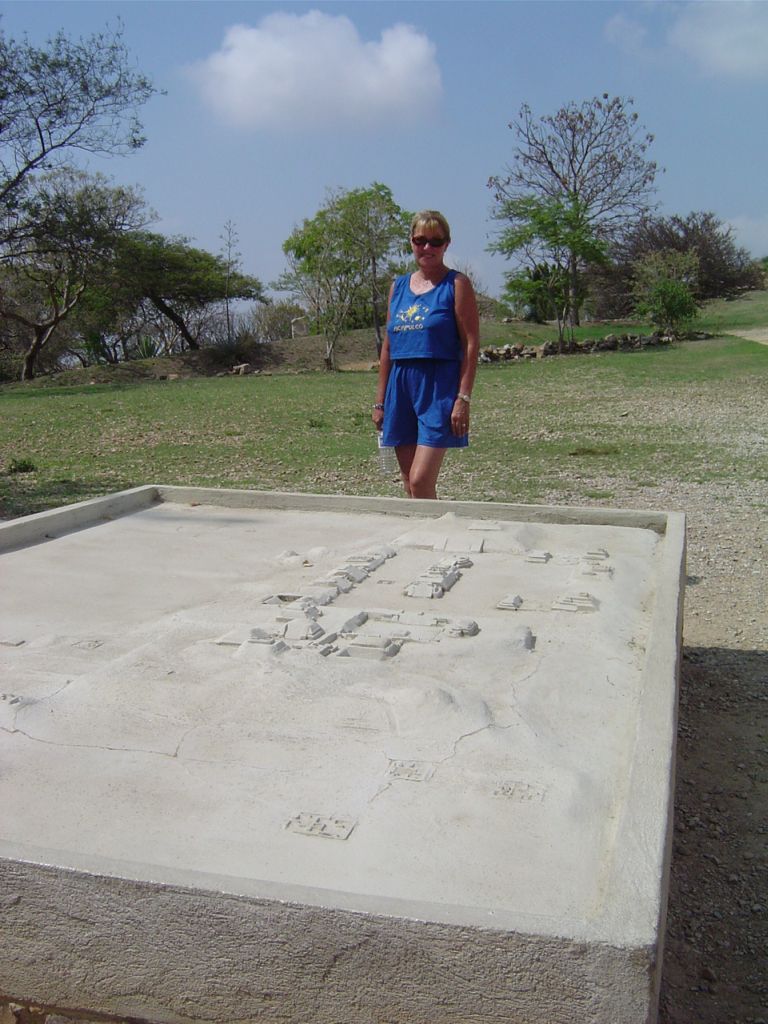
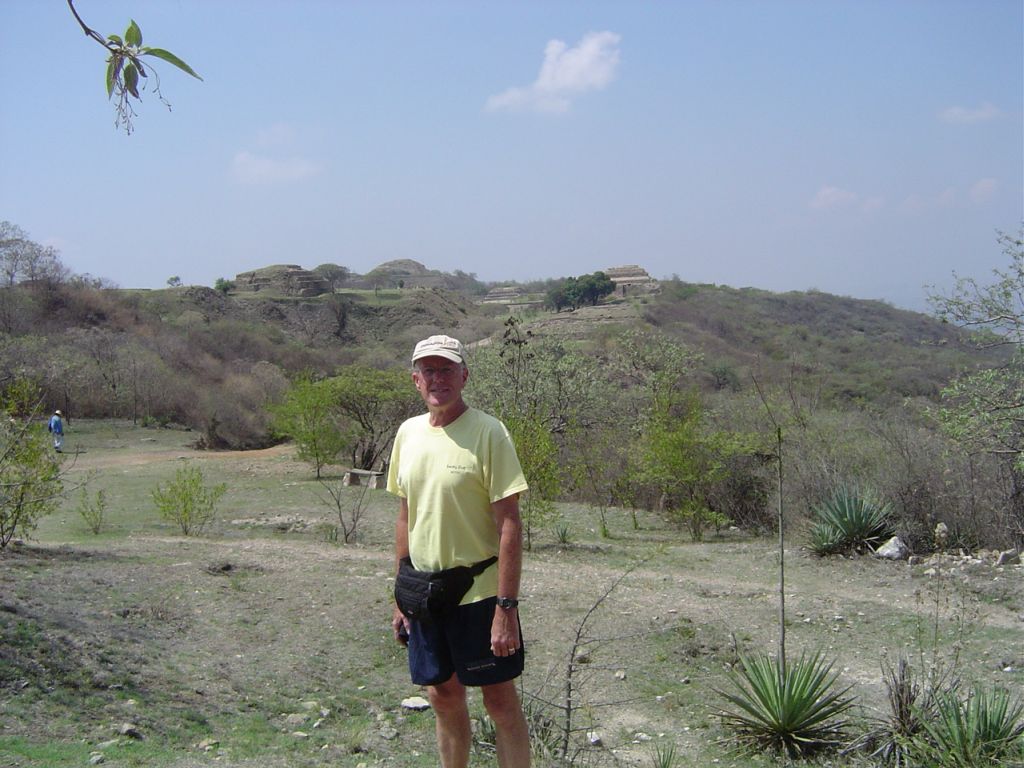
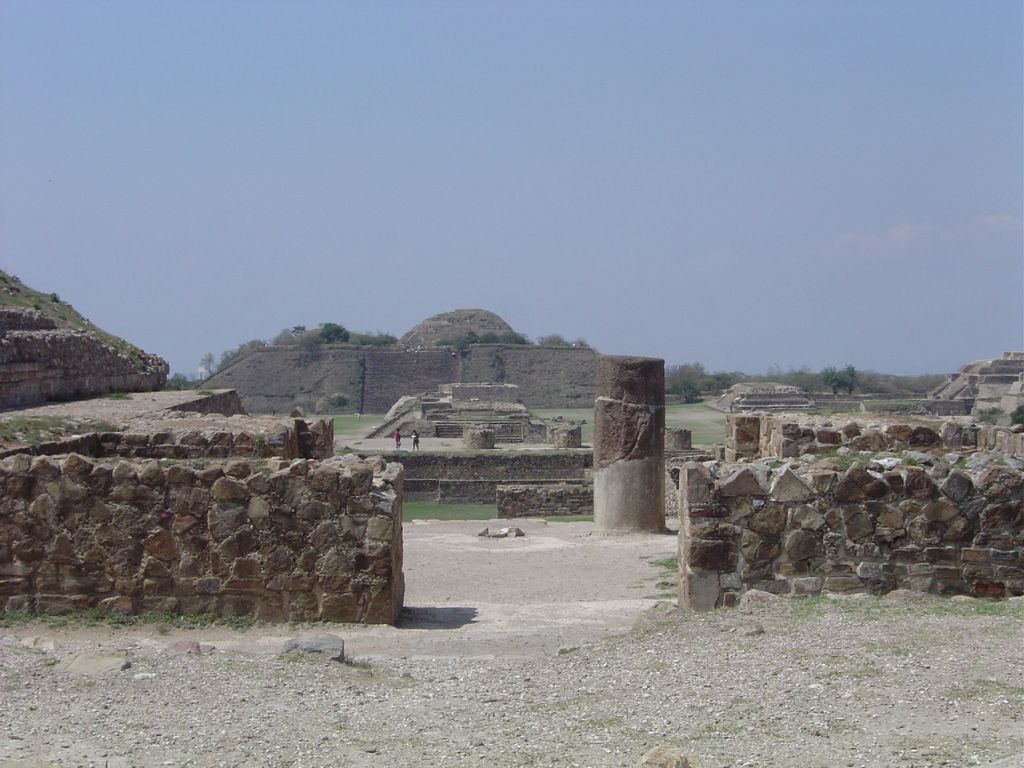
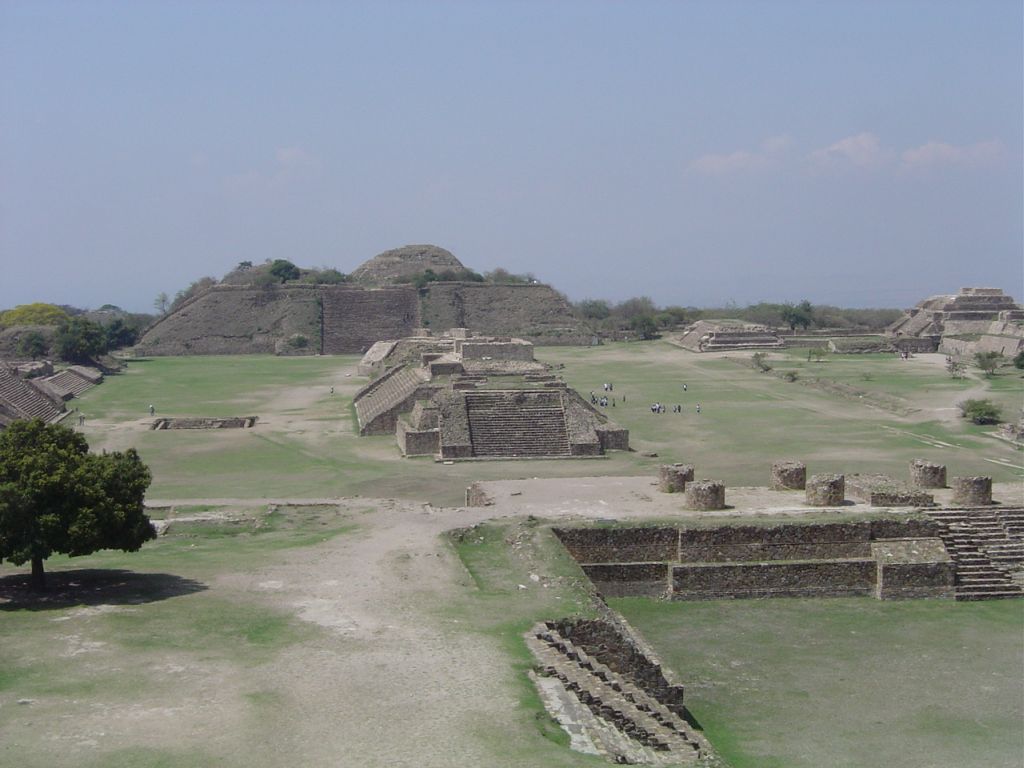
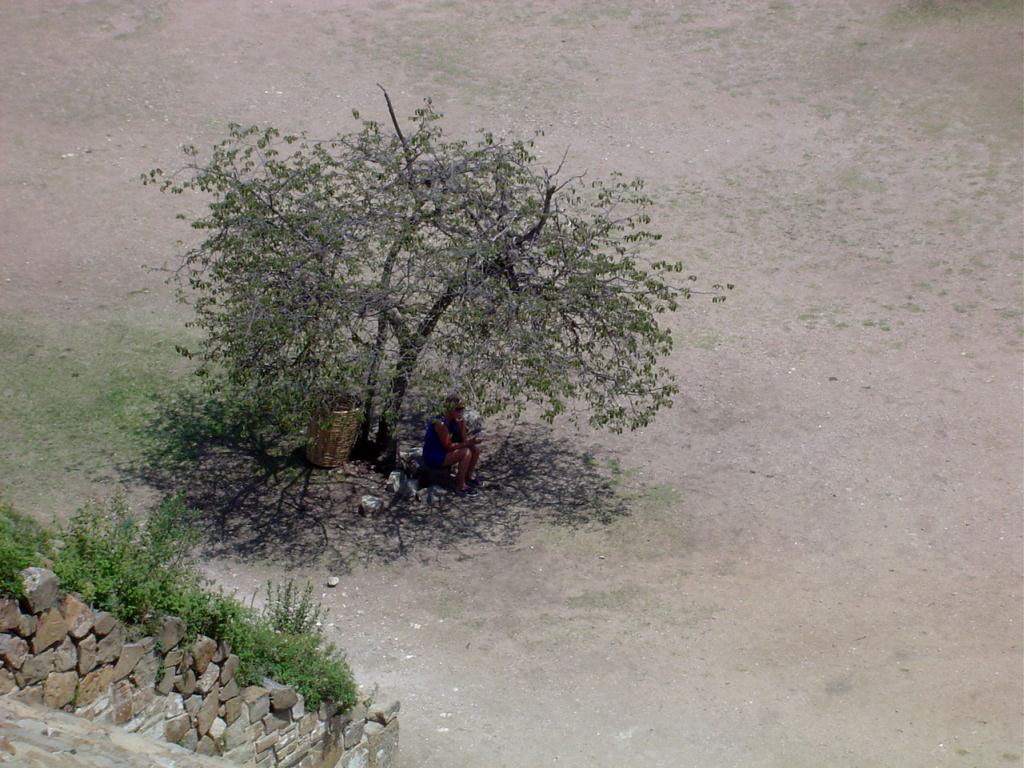
Shade is where you find it.
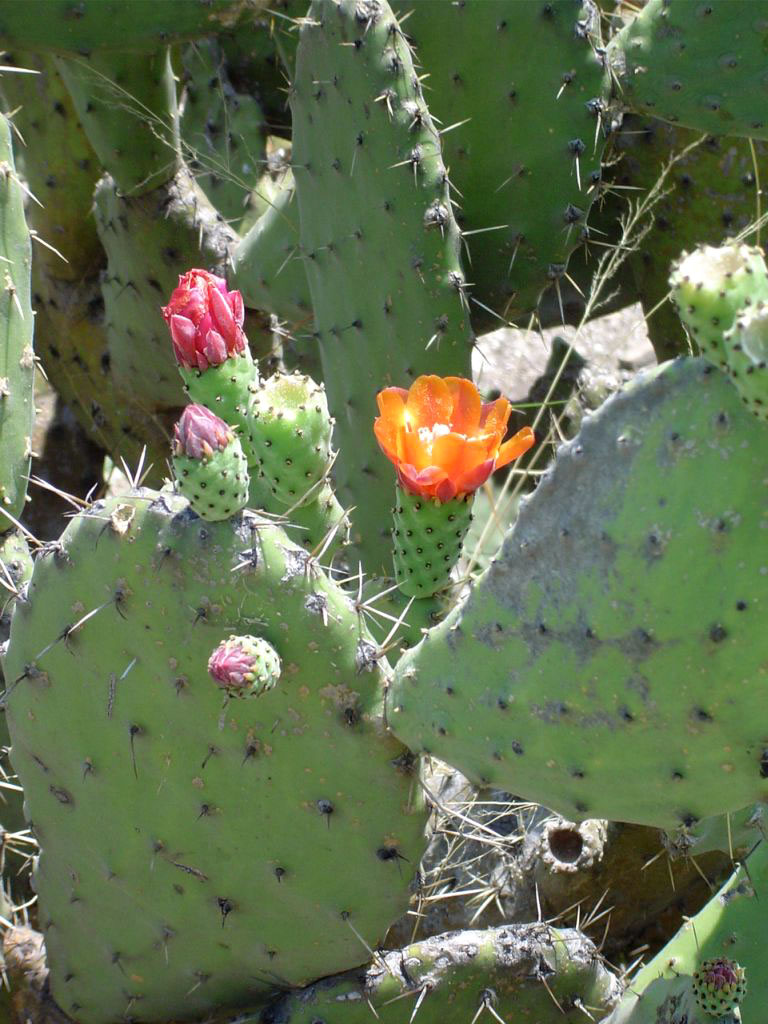
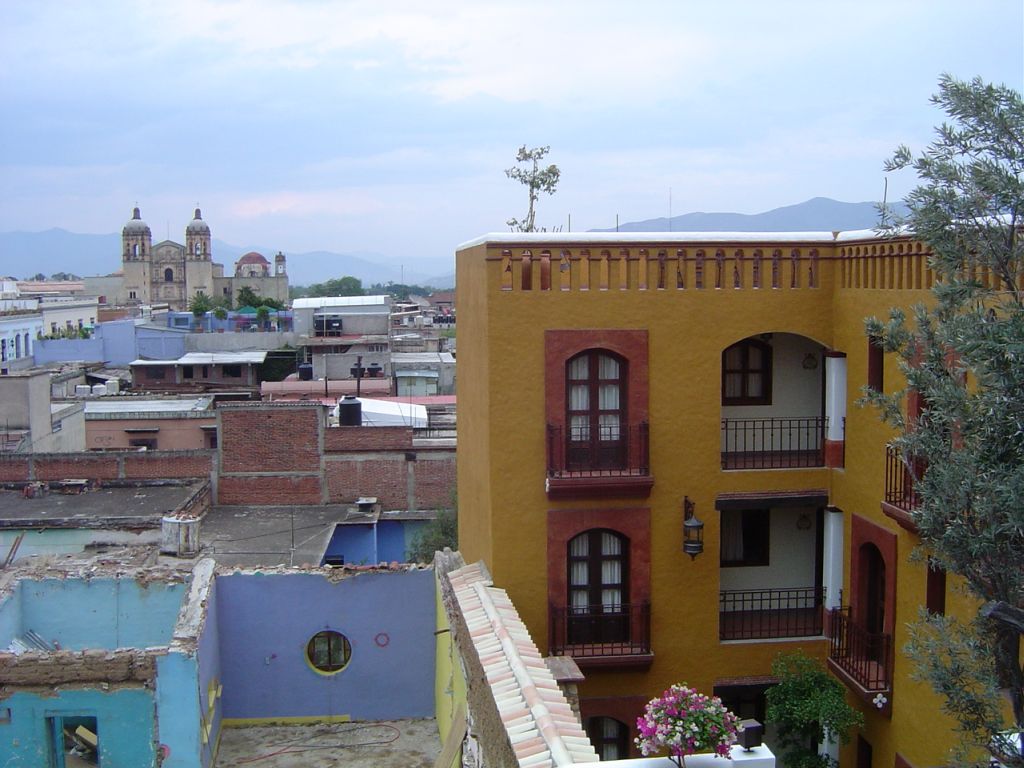
May 12th
Oaxaca to Tehuantepec
Staying in Oaxaco another night allowed us to get an early start the next morning. We were out of the parking garage and on a smooth, straight road by 8:00 AM.
A travel brochure picked up from the front desk at the hotel in Oaxaca described a unique waterfall only 20 miles out of town. Just turn off the main road at Mitla, go 17 km out of town to the turn-off, and in 5 more km, you will be there.
The flaws in this plan didn't become obvious until we arrived at the point where only 5 km remained, well past the point of turning back empty-handed. The paved road turned to dirt. Farmers guided herds of cattle and goats beside us as we waited patiently. Others led loaded burros. Two lanes dropped to one, forcing cars to take turns along a stretch of road. Just two kilometers from our goal, we found a rope stretched across the road. The owner of the rope could be persuaded to lower it momentarily for only 10 pesos per person. I couldn't let 2 dollars stop our quest at such short range, so we forked over 20 pesos and pressed on... Just as the buildings we sought came into view, the road ended. Someone had put rocks across the road and added a chain-link fence for good measure. Finally defeated, we were turning around when another car, with real Mexicans (remember, we are "almost real" Mexicans) stopped. They informed us that one was supposed to walk the last 800 meters to the entrance. Elsa was overjoyed at the prospect. We trudged along the perfectly good road, complete with the obligatory topes. All we needed now was for the sun to come out and start cooking us. At this point, the sun came out and turned a rather pleasant day to a scorcher. Another 20 pesos passed into oblivion at the park entrance. The falls were not yet in sight, only another path so steep and rough that a twisted ankle was a real possibility. Elsa gave up; she would be content with any photos I might obtain.
I pressed on, thinking back to the guidebooks description of this magnificent natural wonder. Moments later, there it was... a three-foot tall wrought iron fence circled it, no more than three feet across. A trickle of water was flowing out of a little hole in the rock inside the fence. It ran under the fence, over to the edge of the big rock and disappeared. The World's Smallest Natural Wonder.
By the time we returned to the main road, it was noon, so we had lunch only 20 miles from where we had breakfast.
I'm sure I'll be reminded of the glory of this adventure when we reach the Iguazu Falls in Argentina.
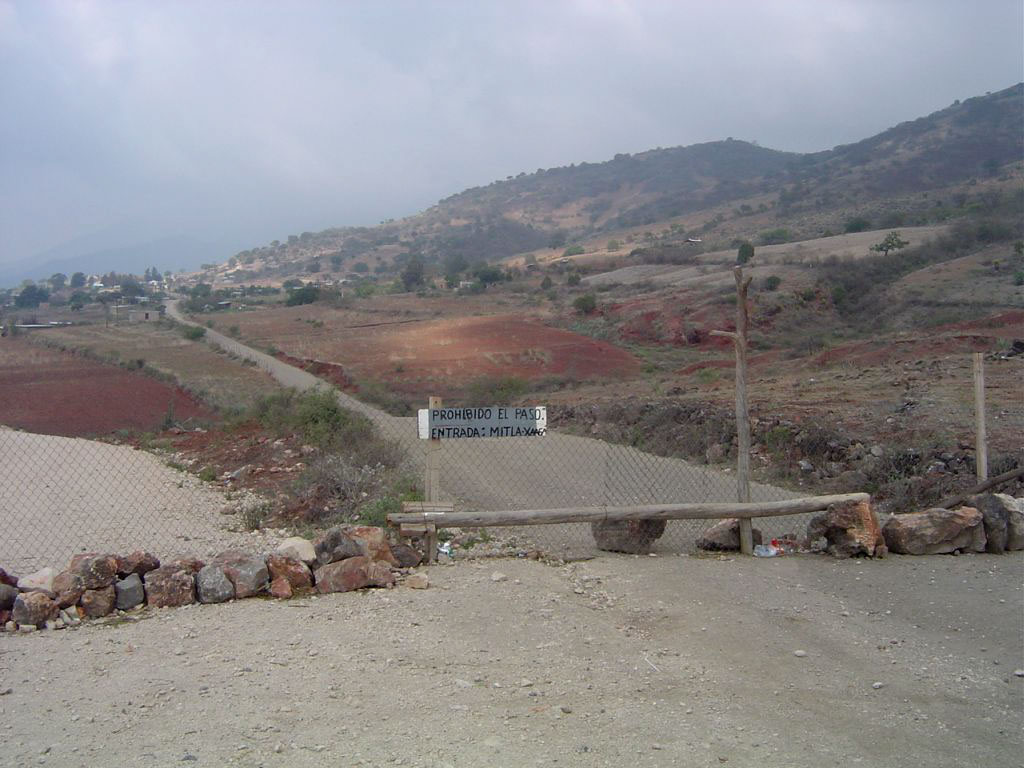
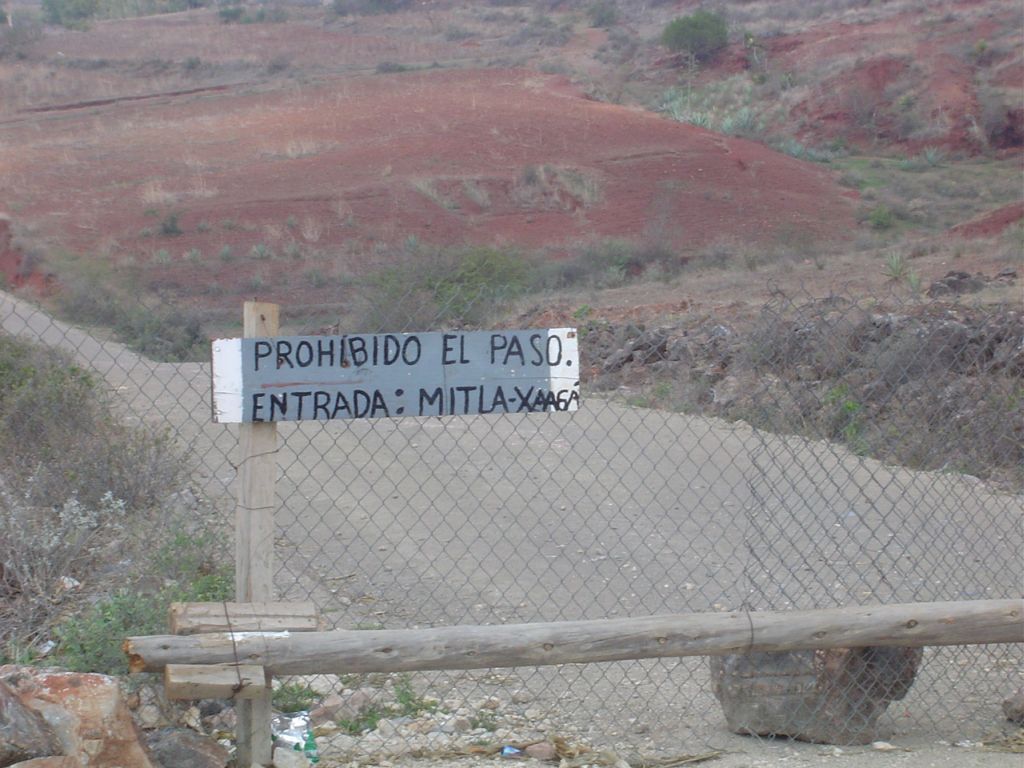
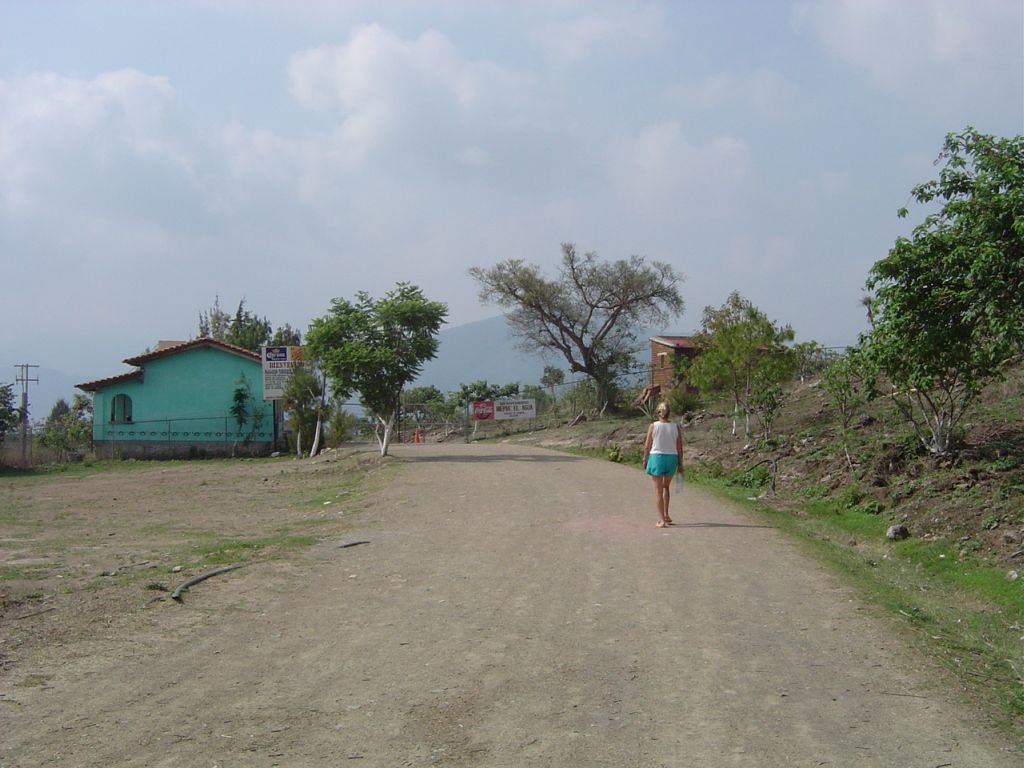
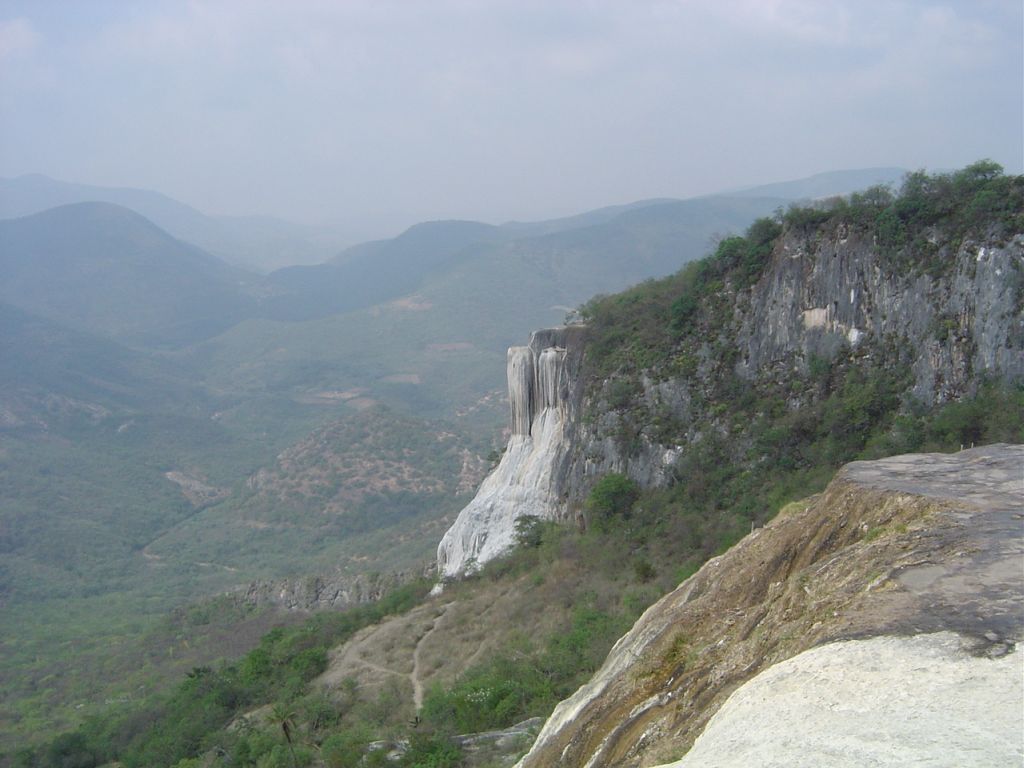
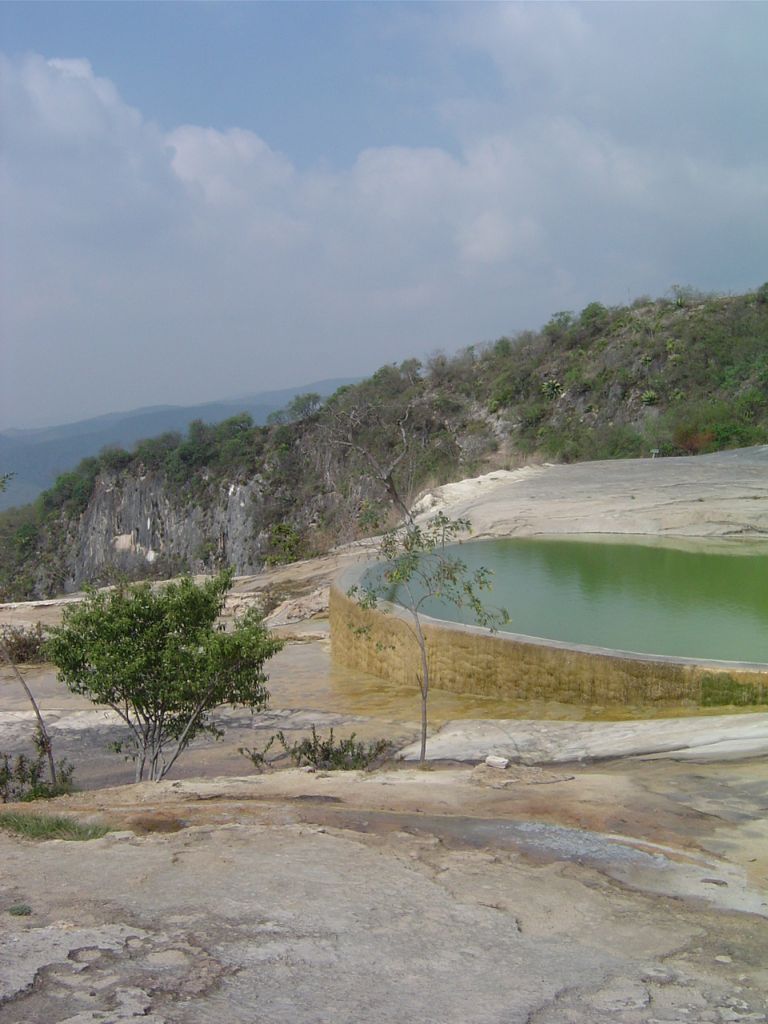
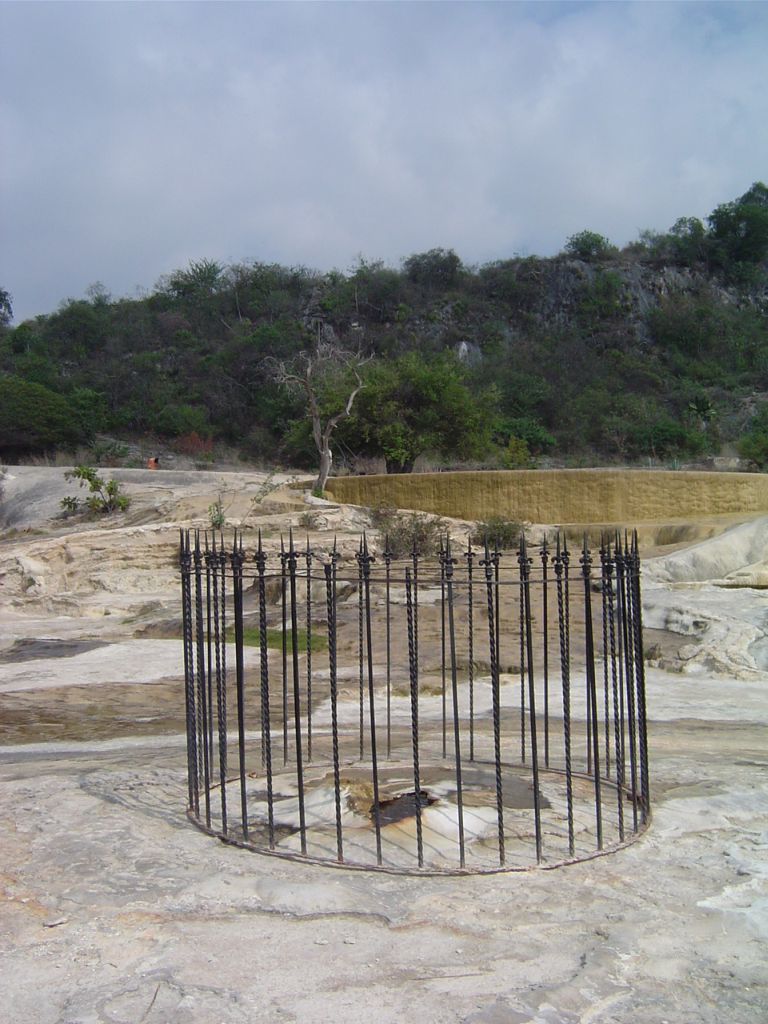
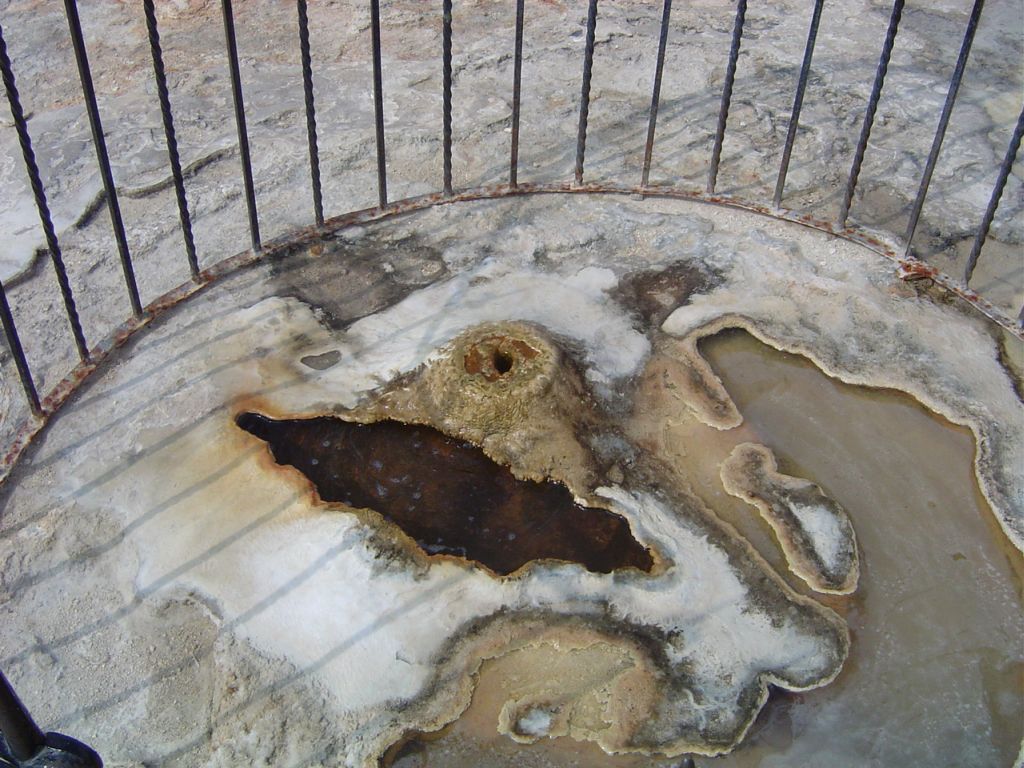
World's Smallest Natural Wonder
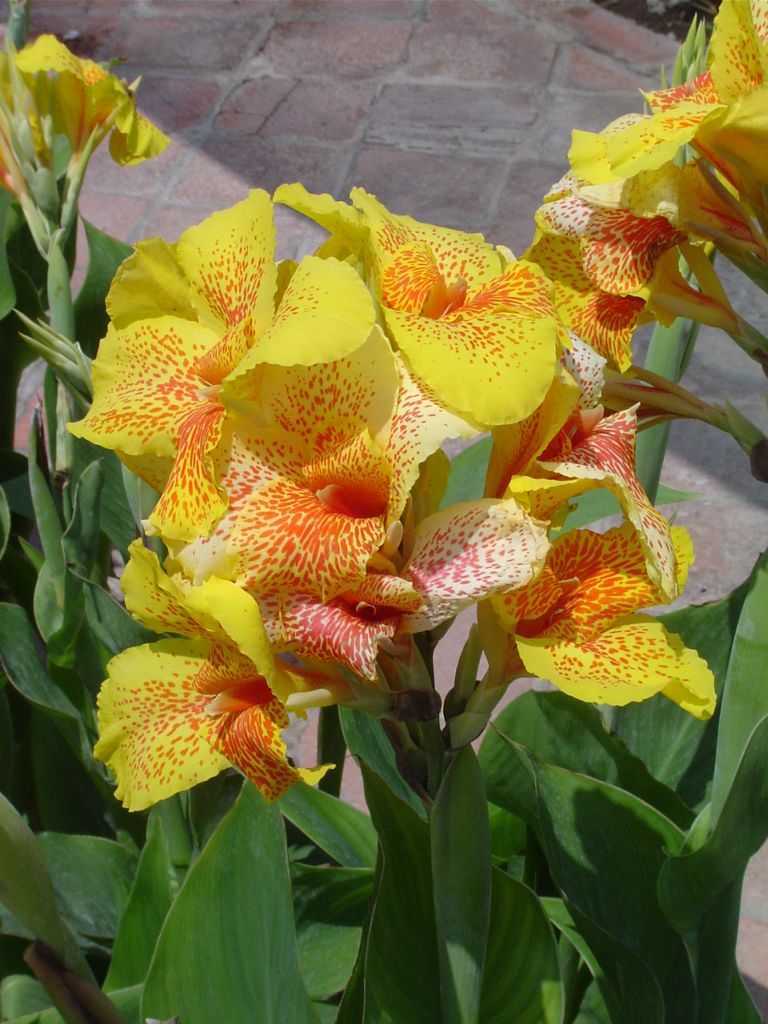
May 13th
Tehauntepec to Tapachula
We had no right to expect that we would be able to make 250 miles in one day, based on the pain involved in going only 180 miles on previous days. The road straightened out and, with Speedy Gonzales at the wheel, we made it by 2 PM.
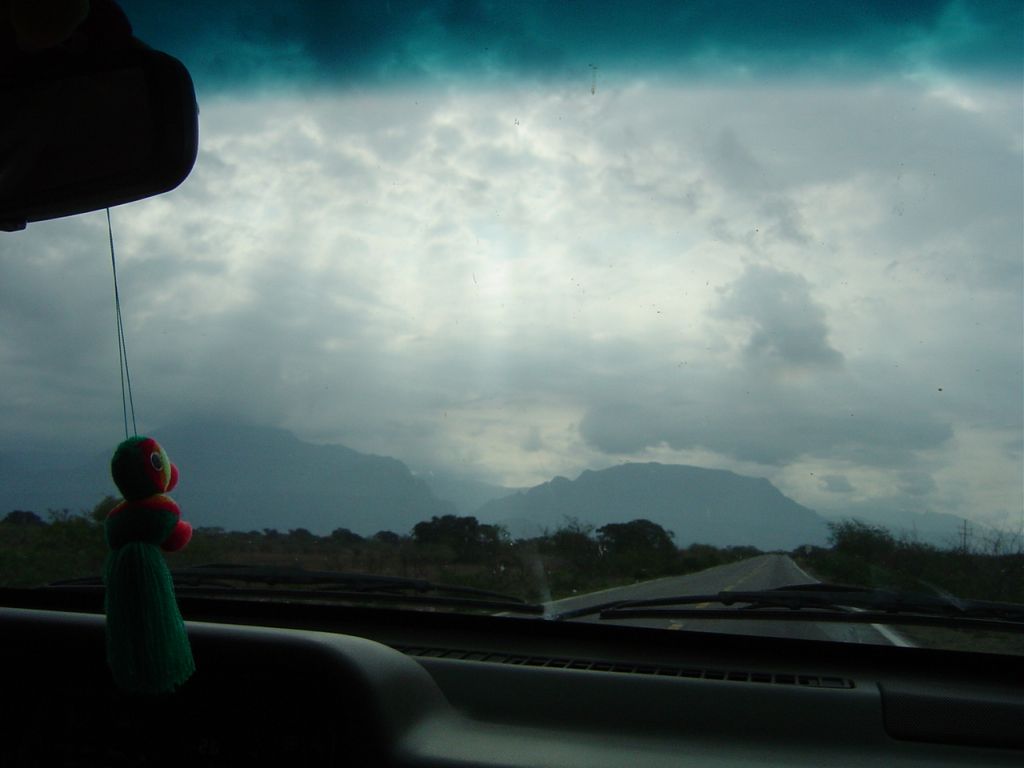
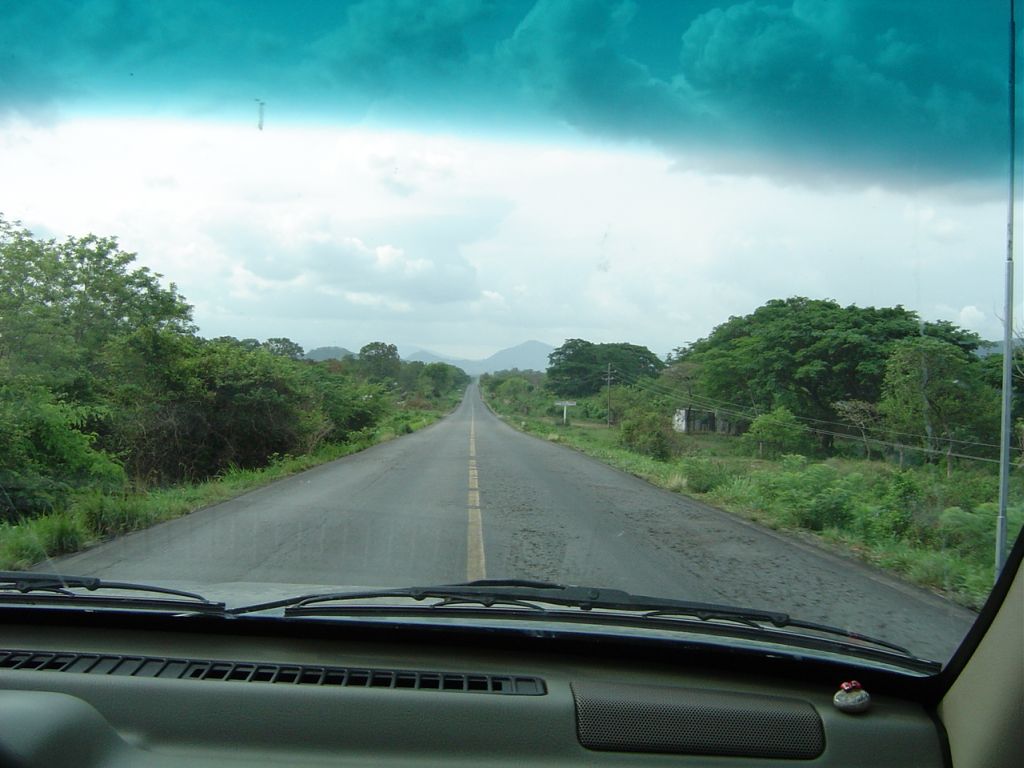
May 14th
Tapachula, Mexico to Quetzaltenango, Guatemala
The book says that most people skip bringing a car into Guatemala due to the hassles involved in the border crossing. They know whereof they speak. We arrived at Tallisman, on the Mexican side of the border at 9:00AM and were shuttled off to a parking area reserved for those with incomplete paperwork. Twenty Mexicans approached the car, offering services from money exchange to paperwork help to merely guarding the vehicle. By virtue of his command of English, one small fellow worked his way to the top of the list. He escorted us to the crossing guards who informed us we needed a piece of paper from an office 27 km back in town... Manuel offered to guide us for 50 pesos, which quickly dropped to 20 pesos. Sensing this to be two dollars well spent, we took off with Manuel stuffed between pieces of luggage in the back seat. Without him, it would have taken us the better part of forever to find the right room in the right building at a checkpoint organized to aid those entering Mexico, not those leaving. We returned to the crossing point and proceeded across the border, parking in front of an office that offered tourist visas and car entry papers. Manuel assured us that his pal would take care of us...
All we needed to do was fork over our passports and relax for two hours. The part about waiting for two hours hit Elsa's hot button; this was not going to happen, nor was handing over a passport to a stranger. So I asked what the costs might be... just $42 US for each tourist card and $280 US for the car papers. Elsa threatened to report him to the police for highway robbery.
World War Three could have started today, but Raul, a resident of Costa Mesa, California, happened by at the right moment. He informed Manuel's pal that the police would be called to investigate his charges, in case he missed Elsa's offer to do the same. Manuel got his 20 pesos and Donald Trump's tag line, "You're Fired." Raul, already a day into the process, took us in hand and got things moving. Off to the Immigration office across the street for a passport stamp, back to the copy center to copy the page with the stamp. Then on to the Customs office where we paid 18 Quetzals for more papers that finished off the people part. Then back to the copy center to duplicate the paper we got at the first Mexican office, showing that our car really left Mexico. The Jeep was then moved up to the Customs inspection station, where the tires were sprayed with some disinfectant. Another guy behind another window took copies of the registration papers and gave us paperwork to take to the bank, just around the corner. 41 more Quetzals changed hands. We handed the bank receipt back in and our auto papers were passed out another window where an official attached a sticker to the window. Done, finally!
Elapsed time, three hours. Total cost, 8 US dollars. Experience, priceless.
Guatemala is as lush and green as Mexico is brown and dry. Not even politicians could make one country differ so much from its neighbor within the distance of a few kilometers. The road climbed quickly to 8400 feet and light rain started, turning heavy at times. The temperature dropped from 85 to 47 degrees. Clouds tops and fog, below us in the valleys, were reminiscent of Austria.
Our high opinion of Guatemala started slipping after lunch. Towns we entered provided no clue as to which way led out. People Elsa approached had, apparently, never seen a map or heard of Guatemala City. She stopped a taxi in the middle of the street; the driver had no clue. She then climbed aboard a city bus stuck behind the taxi; the bus started on its route with her still aboard, carrying her away as she asked people on it. Two police officers finally came up with a route out of town.
We ended up in Quetzaltenango, at Hotel Pocholo, a welcome sight after following stinky trucks all day. The rain finally stopped falling, but the temperature didn't. It got down to 45 overnight, 40 degrees below the high of the day, due to the high altitude
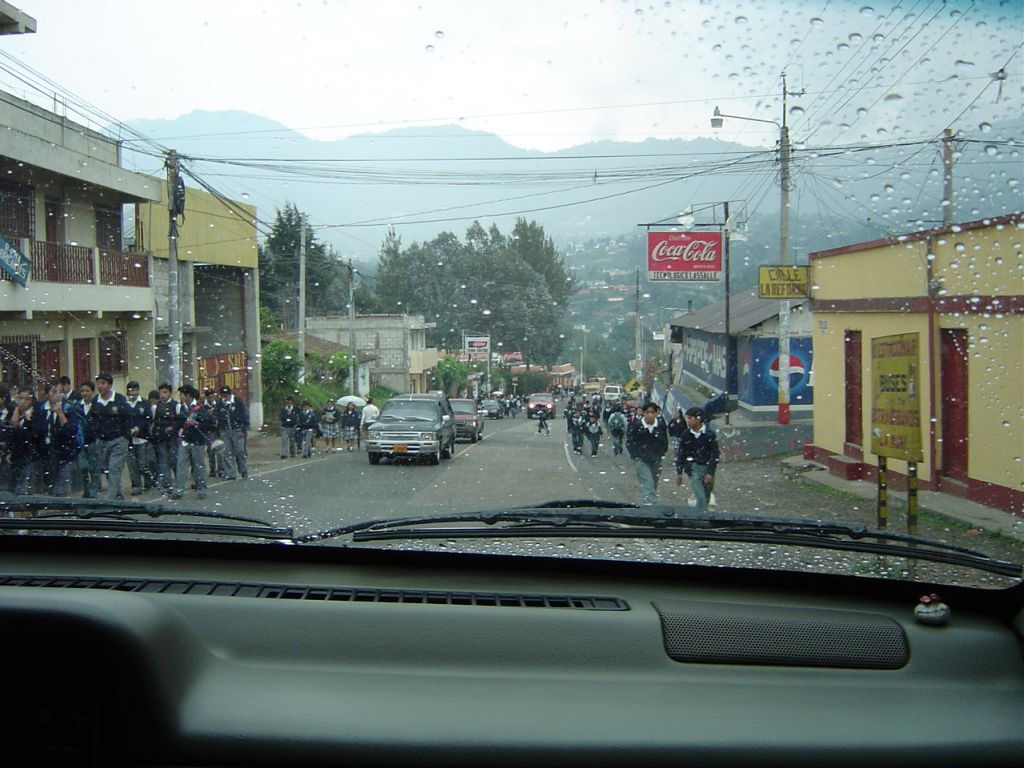
Kids walking home after school on a rainy day
May 15th
Decided to stay in Xela (SHAY-la) as Quetzaltenango is also known. The hotel owner took pity on us a we stood out on the street, trying to flag down a bus and drove us into the town center where we went to the bank, did the Internet thing and wandered through the park and the surrounding shops. We had lunch deep inside a farmer's market, where plucked chickens sold next to five different kinds of corn, only to find ouselves sitting next to two college girls from Los Angeles, who were doing volunteer work for a local hospital.
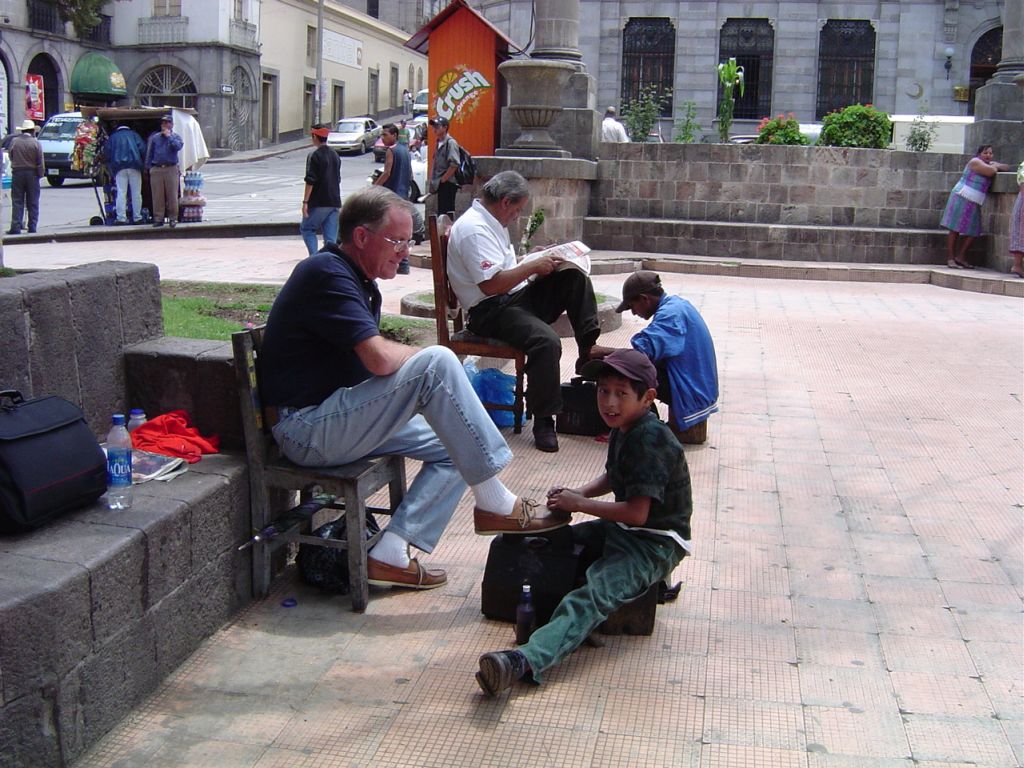
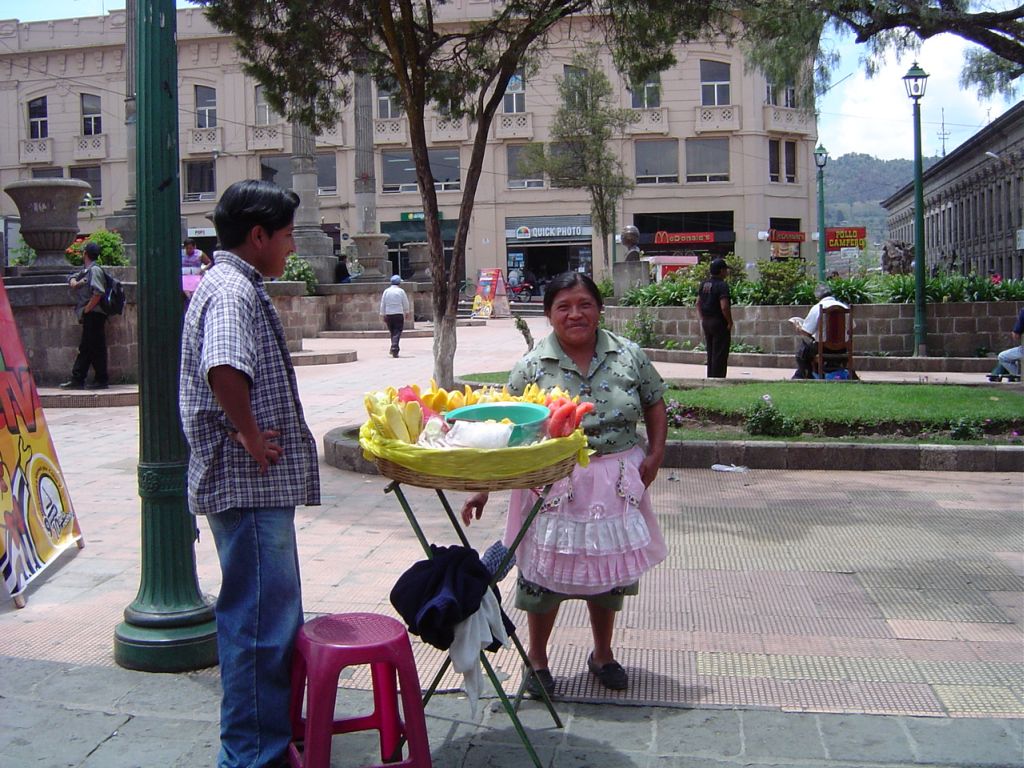
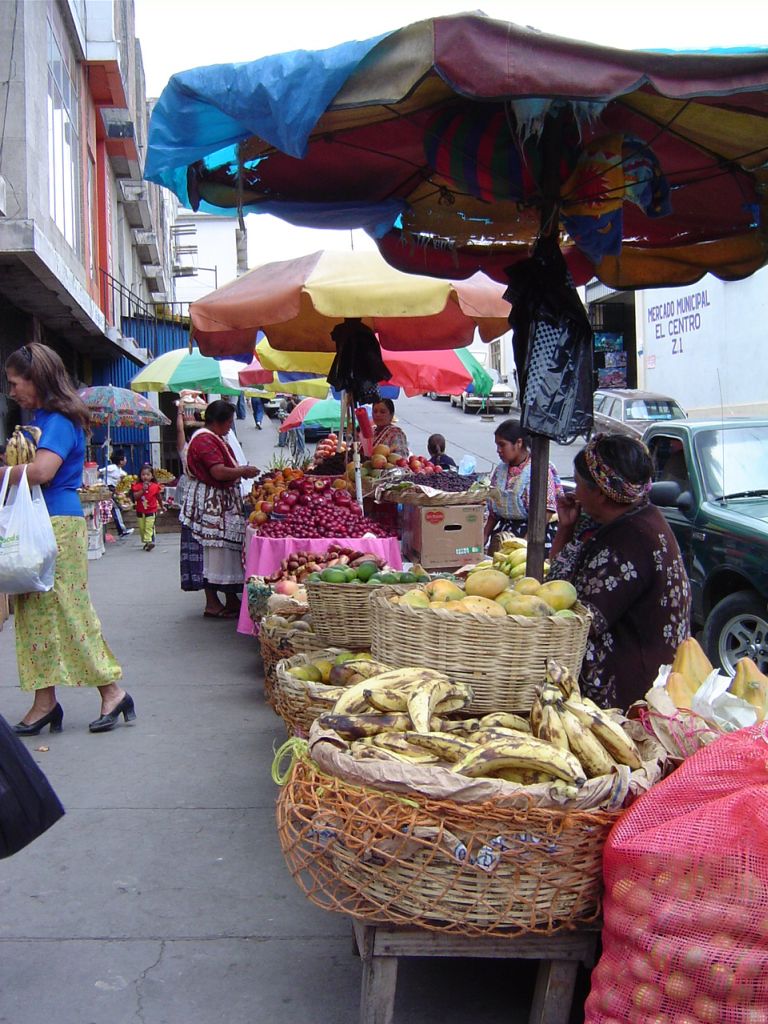
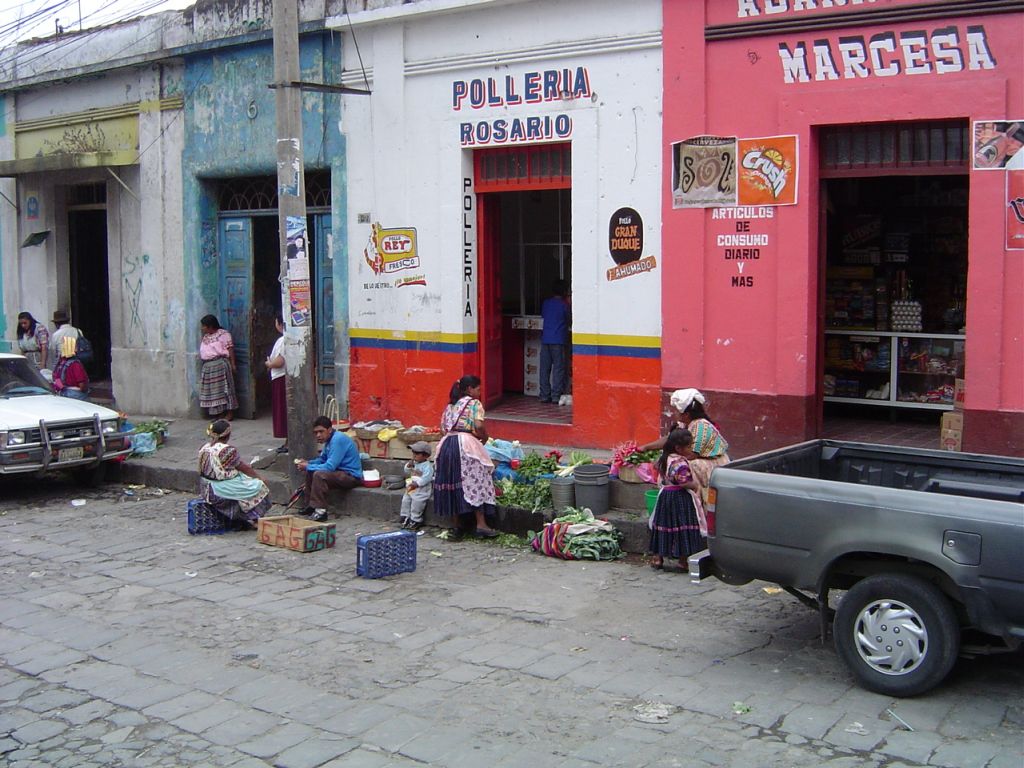
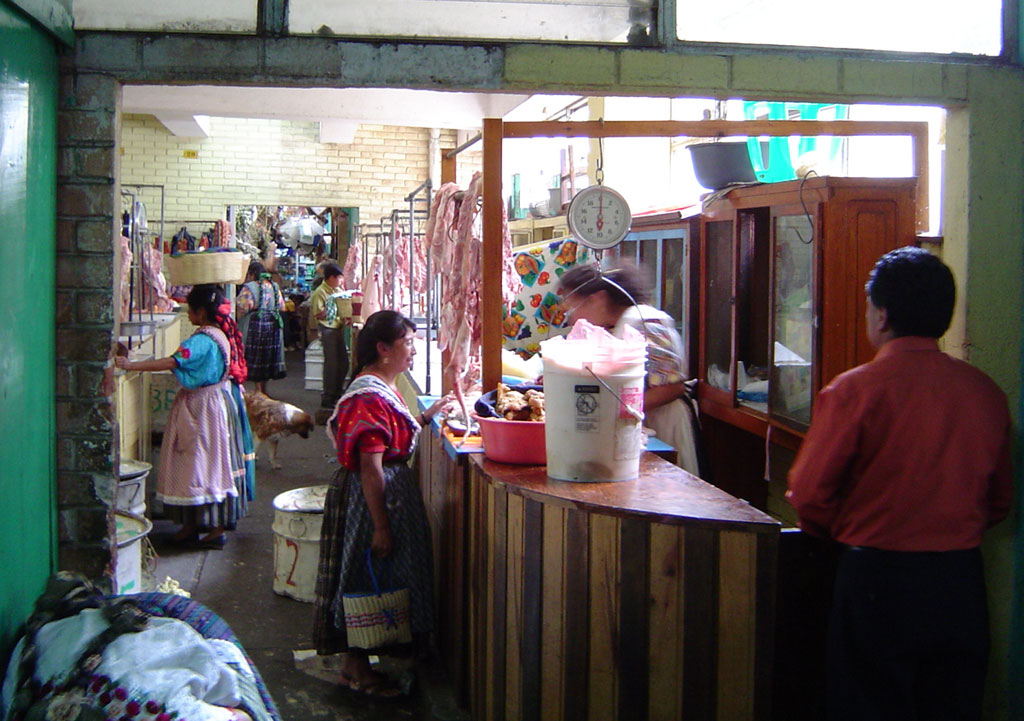

Municipalidad Quetzalteca
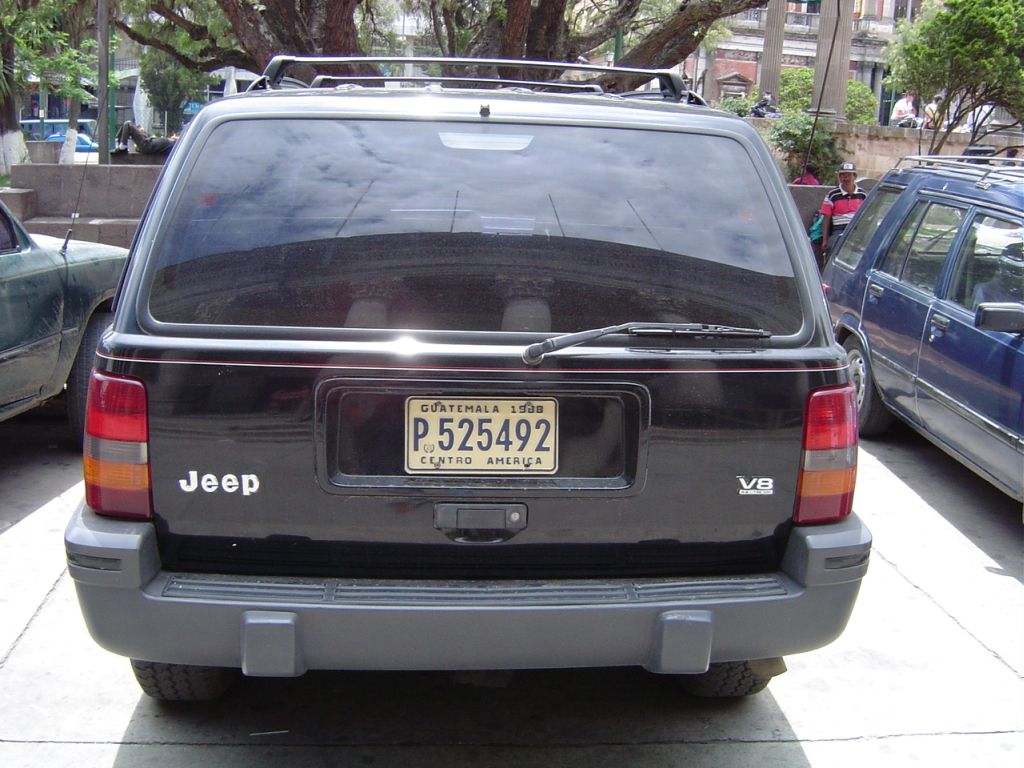
Welcome to Guatemala
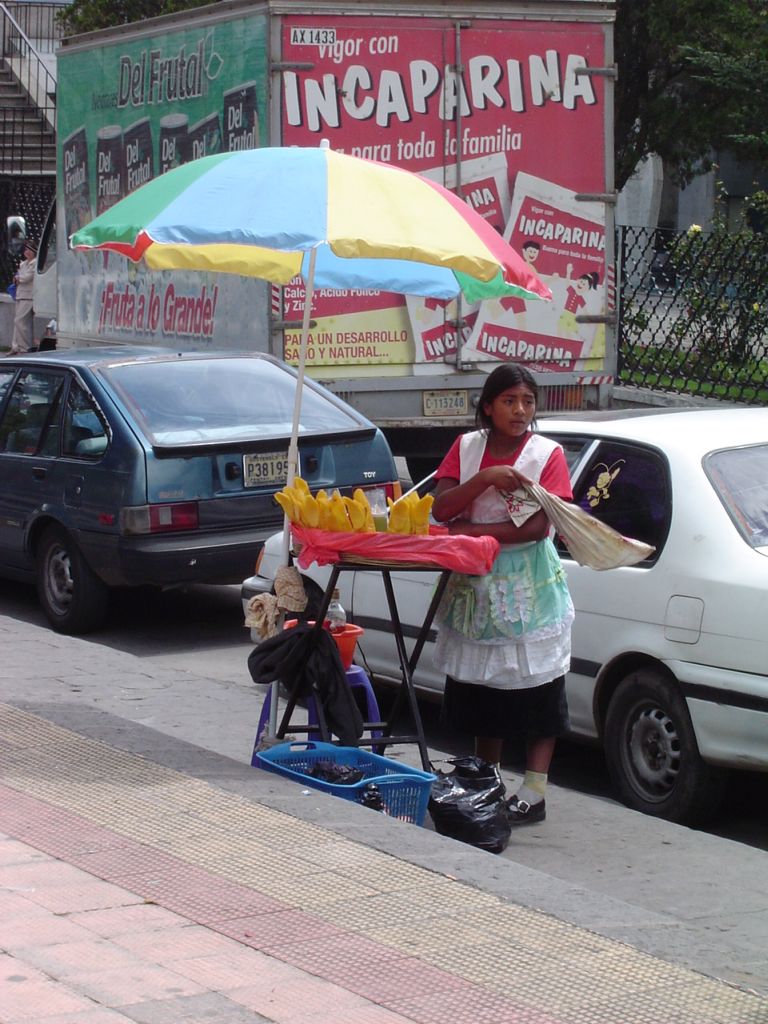
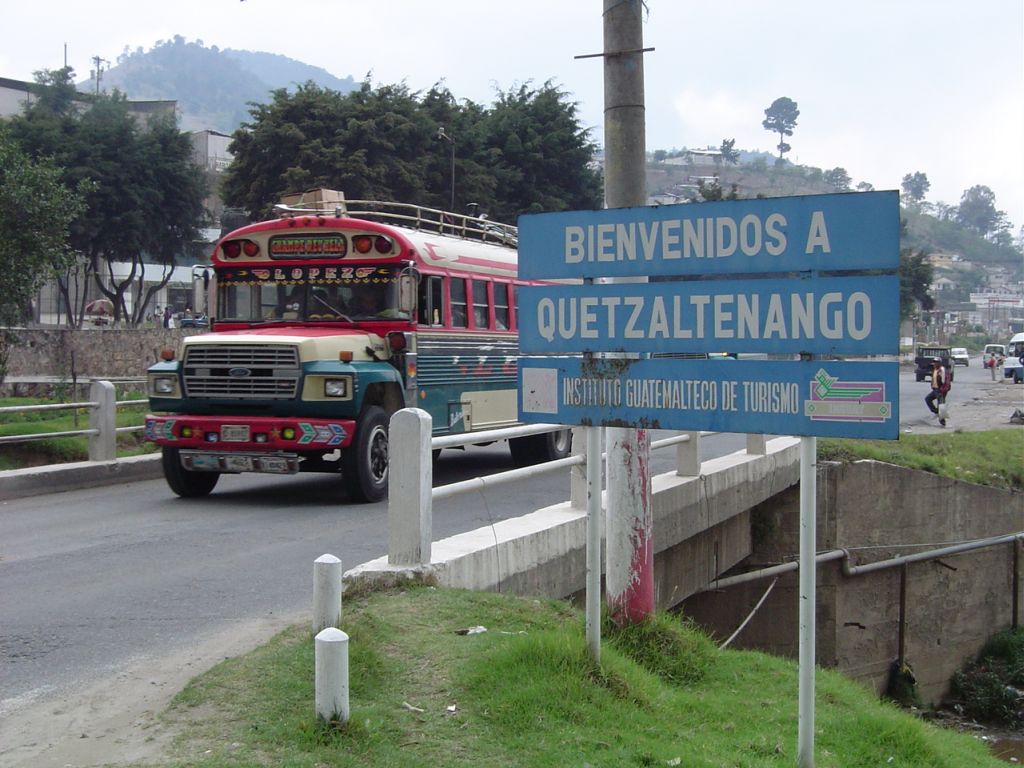
Quetzaltenango means "the place of the quetzal bird"
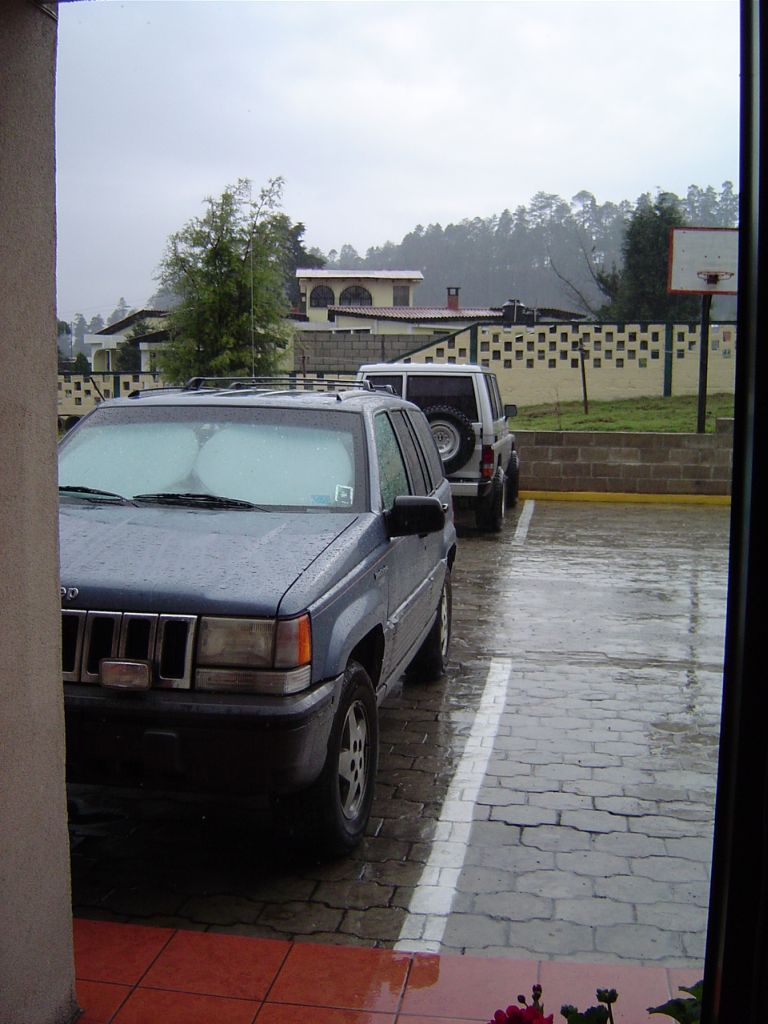
The rainy season runs from May to October